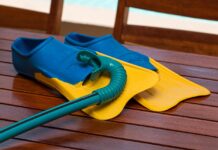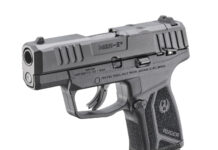
Repeating shotguns became an important part of the firearms scene beginning with the Winchester 1897. With its reliable trombone action and exposed hammer the ’97 is still in service with many shooters. While the open bolt rotary magazine Roper and various odd ball shotguns were developed the Winchester proved to be a reliable and useful shotgun. Marlin and Winchester butted heads over lever action rifles and are still worthy competitors. Marlin introduced a pump action shotgun similar to the Winchester 1897. While never as popular as the Winchester the Marlin was a robust and reliable shotgun. All Marlin shotguns were take down models. The original 1898 Marlin was followed by other models ending with the Model 24 to the best of my knowledge. The Marlin doesn’t command a lot of money yet it is a pretty cool piece with plenty of history behind it.
While there were some military models manufactured the majority of Marlin shotguns featured 26 to 32 inch barrels. While offered in 12 gauge there is a rare 16 gauge model. Depending on the exact model and its period manufacture the shotgun may feature a semi pistol grip or a straight grip. The shotgun was manufactured in several variants. Among these was the lighter model 19. Some featured a glare fighting matte finish on the receiver. I don’t like to comment on problems with which I have no personal experience but it seems that early Marlin shotguns suffered from something called ‘false battery’ and may have fired when not fully locked. The shotgun was further developed into one of the very few drop safe shotguns of the era. Even today few shotguns are drop safe if dropped from sufficient height. This is an advantage of the type. The shotgun bolt was locked on firing and merely operating the bolt and dropping the hammer, does not unlock the bolt. The Marlin features an inertial block. The bolt is locked closed but unlocked by the jar of firing the shotgun. In order to unlock the bolt without firing a push button is located to the right side of the bolt.


The shotgun is smooth and reliable in a well maintained example. It is interesting that while the Marlin has good safety features the type has been banned from Cowboy Action Shooting due to safety concerns. This bears some explanation. Many early Marlin shotguns were chambered for 2.5 inch shells. Later models chambered 2.75 ( 2 ¾ inch) shells. The problem is that a 2.75 inch shell will jam into the chamber and fire. If the load is strong enough damage or even a burst shell is the result. While the Marlin 1898 shotguns are strong variants God help the person firing a high brass shell in a 2.5 inch chamber! Later shotguns are fine with the longer shell- and 2.5 inch shells are available. Just the same this requires more preparation than simply grabbing a Winchester 1897 clone and ripping off a few shells.
The other problem is probably the more serious. Remember the false lockup? While cured in later models the push type plunger is problematical if you are not very careful. As it turns out those speed chucking the Marlin in competition sometimes hit the button while handling the Marlin. As a result the Marlin might fire while out of battery and apparently has done so on occasion. So we have the unfortunate situation of a quality shotgun with excellent safety features being banned from competition. Just the same this is a reasonable thing to do. I don’t think I am taking my life in my hands firing the old Marlin or I would not fire it. Just the same be certain to check out the shotgun for haze cracks and be very cautious in firing the shotgun- and especially determine the proper chambering. Even those chambered in 2.75 inch were intended for early shells with a different style of roll crimp.


The example illustrated is a trade gun. This is a gun made by one manufacturer and labeled for a chain store. There were many Western Auto shotguns and J C Higgins manufactured by American makers and re-labeled. Today the same circumstance exist with millions of Turkish shotguns relabeled. As an example you pay quite a bit more for a Mossberg, Weatherby, or Winchester marked Turkish gun- may as well save a hundred bucks or so and purchase a Turkish gun at Cheaperthandirt.com! Just saying- makes sense to me. The trade name of the Marlin in this case is REVONOC by Hibbard Spencer & Bartlett. I am pretty certain the shotgun was manufactured about 1906. No way to be certain. Factory records were lost. Many records of older makers were lost during World War Two. They were donated in paper drives. Floods and fires took a toll. Just the same the Marlin types have little collector value. Most seem to have seen much use in the hunting field. The 12 gauge model shown shows even consistent wear rather than eccentric wear. Considering the age the shotgun has been well taken care of. Have I fired it? Sure, after a careful safety inspection. I would be very hesitant to fire an earlier version without the bolt lock plunger. But then I am no expert or even intimately familiar with this type of shotgun. I would recommend locking the shotgun in a fixture for the first shot if you must fire this type of shotgun. I did so with an old T shirt wrapped around the bolt to detect gas leak. Works for me and I have fired the shotgun with standard birdshot. This shotgun has the special order straight stock we would call a skeet stock these days. This shotgun points and handles well. It was in the game field at some point as when I first purchased the shotgun it had a plug in the receiver limiting capacity to two shells per state law. I haven’t removed the plug, no point, I may take it bird hunting for the fun of it.
The Marlin hammer guns are an interesting bunch. I enjoy owning mine and occasionally handling the piece and wondering what hunts it was in on the past one hundred twenty years. They remain affordable and make a good conversation piece. But don’t put it on the front lines!



